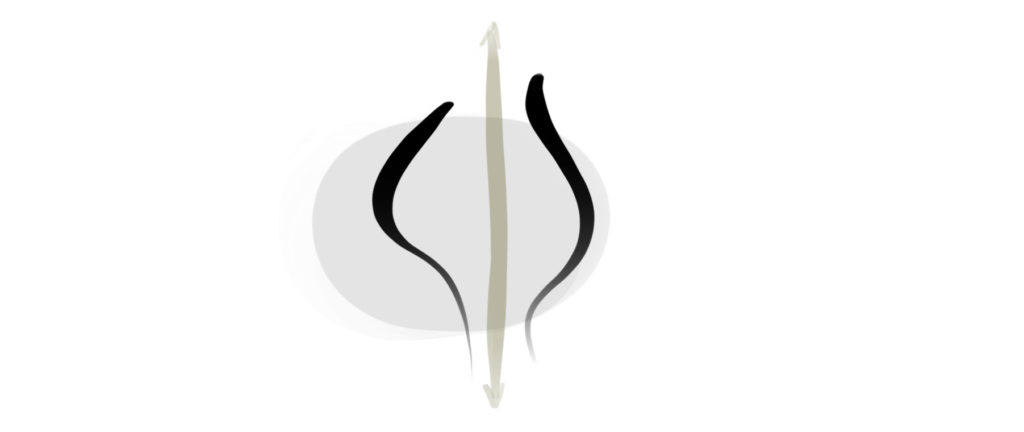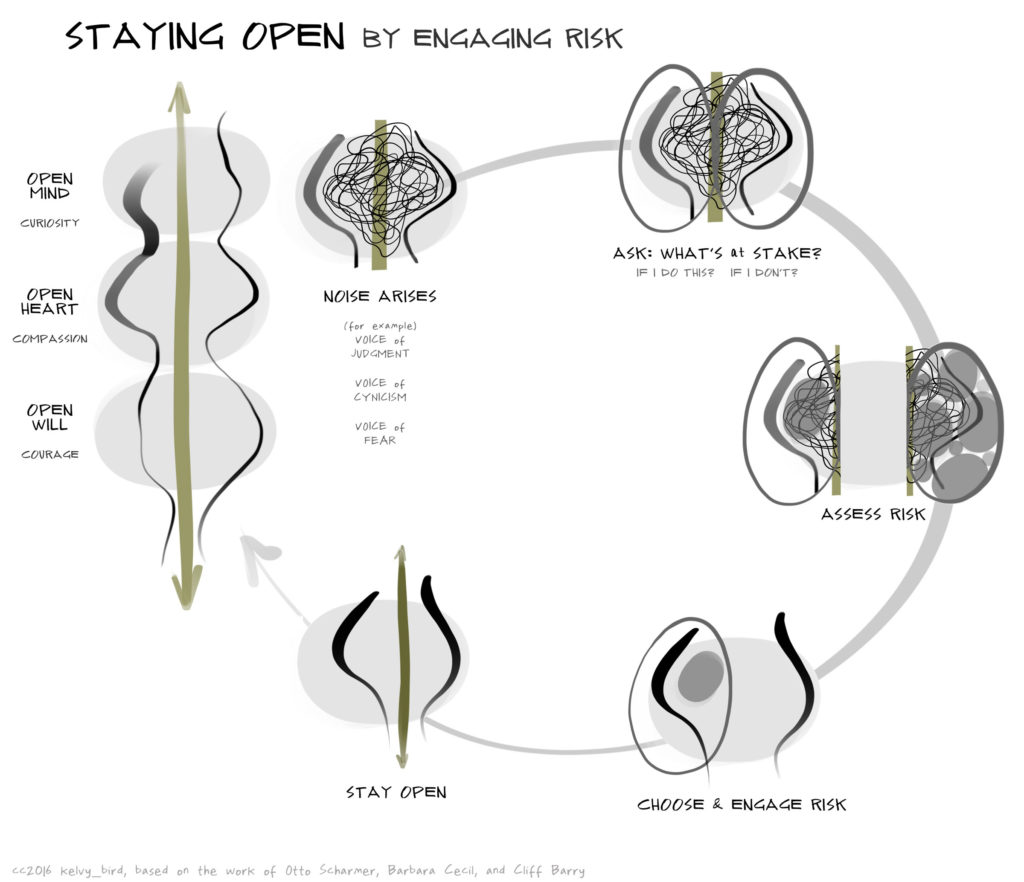 Scribes need to stay open. It’s as simple as that. If we start to close down, we miss what is being said, get lost in our own heads, and disconnect from the flow. Staying open is a key skill to manage, and the challenge to do so – while listening and drawing – is constant.
Scribes need to stay open. It’s as simple as that. If we start to close down, we miss what is being said, get lost in our own heads, and disconnect from the flow. Staying open is a key skill to manage, and the challenge to do so – while listening and drawing – is constant.
Referring directly to Otto Scharmer’s Presencing work, there are three key capacities to cultivate:
- an Open Mind, where we Perceive clearly
- an Open Heart, where we Join others where they are
- an Open Will, where we Know what wants to be seen and made visible and from where we Draw
Yet quite often we encounter voices that block the path:
- Judgment restricts the Open Mind
- Cynicism restricts the Open Heart
- Fear restricts the Open Will
During one u.lab[i] session in 2015, the community further surfaced that to relax judgment, we inquire and become curious. To relax cynicism, we find compassion. To relax fear, we activate courage.
Sometimes these voices are sticky, though, and even if we’d prefer a more enlightened approach, we just need to figure out how to keep drawing. Shutting down is not an option when your back is to 10 or 1,000 people eagerly anticipating your images!
What’s at Stake?
Sometimes when I feel very stuck in any of these capacities, I refer back to a ShadowWork exercise learned from Barbara Cecil. When facing a dilemma, a coach will ask: “What’s at risk for you to do this?” And the coachee responds with all the reasons and voices, in body and mind, that feel the risk.
Then the coach asks: “What’s at risk if you do not do this?” Again, the coachee responds with all the perceived risk if nothing were to change. And in playing out the two sides of a stuck situation, the needed move – and appropriate risk – becomes clear.
Sometimes we can move through stuckness and engage a more adventuresome part of ourselves. And sometimes, when the risk feels too high, we need to choose a smaller level of risk on which to act. And either case is completely fine. What’s important is to be honest about how far we can go internally and just keep going, as openly as possible.
For example, if we want to stay open-minded, yet find ourselves in a room of overwhelming judgement – like a room of people with opposing political views who criticize our favorite politician – it might seem too challenging to neutrally represent their conversation. The risk might be between 1) holding firm to our beliefs, therefore somewhat censoring what we hear and write, and 2) suspending our own judgment, inquiring into where they might be coming from, and holding a thread of curiosity for the whole.
Another example… if we end up at a wall, poised to listen with an open heart, and we are deeply troubled by what we are hearing – like ex-sex workers advocating for victim’s rights in the face of perpetrators who are in the very same room – what is the risk? 1) Cynicism that the judiciary system could ever change, therefore our work is futile – why even draw? 2) Revealing bias for the victim and not accurately tracking all parts of the system in play? Considering the safety of the container, and what it can hold, would also be important to consider here.
And another… if we go numb on a stage – like with with a terrifying fear that our minds will blank as soon as someone starts speaking and we’ll lose the thread of meaning and not be able to draw – (no open will), then we can run the quick “What’s at stake?” question to figure out what we can handle to get us over the hump. 1) Draw whatever is understood, even if very little. 2) Don’t draw at all.
In all cases, whenever noise gets in the way of tangible progress, there will be multiple facets informing the eventual freeing up and movement on our path. Choosing between risks is just one option. What i try to remember, at the base of it all, is this:
By staying open we become a channel for what wants to come through. We scribe to be of service for something wanting to be seen. To overcome our inner voices enables that service.
[i] u.lab: Leading From the Emerging Future is an online MOOC (Massive Online Open Courseware) offering through MIT’s edX platform, initiated in January 2015 in conjunction with the Presencing Institute’s u.school ecology, “a global action research platform, and an eco-system of online and offline communities, working to understand and transform the underlying causes of the ecological, social, and spiritual crises of our time.”

Thanks for this Kelvy. After a really great conversation with a colleague last week about listening and storytelling, this helps me continue to think about how I want to deepen my practice and be more supportive for the group.
A question I have is this: What has helped you practice moving from the “need” to capture every little thing said toward listening for the deeper messages and flow of the group?
Many thanks, Karina
Hi Karina – Thanks for the good question. It’s probably a mix of 1) developing trust in my listening skills (which has taken a loooong time and is ongoing!) 2) expanding a capacity for holding key threads of meaning, 3) believing that time is long and what i miss today will come in tomorrow, or the next day, or someone else will bring it into another picture – the world will have it surfaced somewhere if not through me…. and 4) a desire to reflect back the essence of a conversation, not just the data, but the most golden thread possible to carry forward.
I’d add, on a more personal note, perhaps as i age (?) that my tolerance has shifted around “noise”. I seem to want to attend to key insights > all data. I ask myself “What is most precious, most poignant to preserve?” In my first 5-10 years of scribing i DID try to get every word! But now, i think the world has a lot of info in its collective face already, therefore i’m mindful of what i add to that…
Beautiful. When choosing and engaging in risk, a supporting question might be ‘what risk are you willing to take’.
Indeed! “If i do this?” then “If i don’t do this?” then “What risk am i willing to take?” Yes. Tx!!